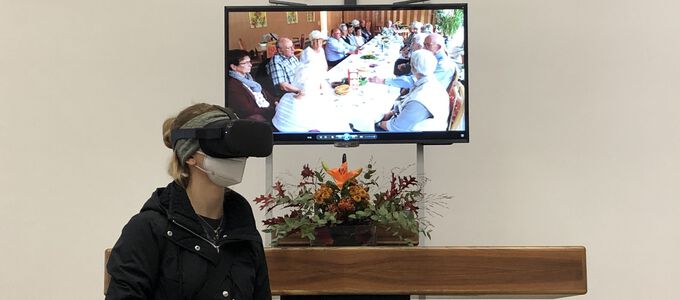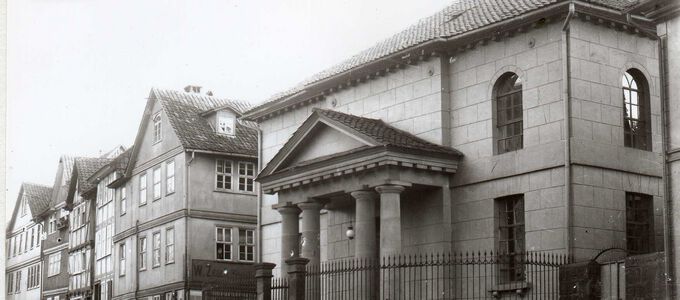
Restoring what has been destroyed: this is what the New Apostolic Church is trying to do in the town of Eschwege in Germany. And they are trying to do this with their church building and the turbulent fate that it has been through.
Oohs and aahs can be heard as people wearing headsets stumble through the church hall, bumping into the odd pew here and there. They seem to be completely mesmerised by the otherworldly digital space they are seeing. This is the scene at the open day in celebration of the centenary of our church in Eschwege. Virtual reality headsets had been provided that simulate three-dimensional scenes to help the visitors explore the church hall as it was in the nineteenth and twentieth century.
A building and its history
The reason for this virtual look into history: the church used to be a synagogue. The Torah shrine, the table for the Thora scroll, or the women’s gallery—with the VR headsets all of this comes alive. Guided tours were also offered so that the visitors learned a lot about the history of the former synagogue.
The synagogue was built in 1835 according to the design by Johann Friedrich Matthei, the master architect of the Electorate of Hesse. It was built as a classical two-storey plastered building. Its walls are made of bricks and the roof is a so-called hipped roof that slopes upward from all sides of the structure. In the centre, one part of the building juts out—the central porch. Four columns line the entrance and the windows are decorated with coloured stained glass. In 1838, the regional rabbi of Eschwege dedicated the synagogue.
In 1890 a rock was hurled at one of the windows of the synagogue, breaking it. Further stones followed, shattering the stained glass. Antisemitism also spread in Eschwege too. On 7 November 1938 the windows of the synagogue were once again broken by unknown persons. And on the night from 8 to 9 November 1938—when Nazis in their pogrom against Jews destroyed Jewish property and synagogues in Germany—a mob destroyed the interior. Those familiar with the area know that the synagogue only escaped being burnt down for one reason: in the densely built-up neighbourhood, the fire could have spread quickly to other houses.
The synagogue becomes a church
This is how the synagogue in Eschwege survived the war, but the Jewish community which had existed in Eschwege since the fourteenth century, no longer needed it. Many of the local Jews did not survive the Holocaust or had fled abroad. After the war ended, several concentration camp survivors ended up in Eschwege and continued to use the building, but they did not want to stay. They started to look for a buyer. Important to them was that the synagogue would continue to be used as a place of worship.
One of the prospective buyers was the New Apostolic congregation in Eschwege. The members had been looking for their own building for a while already. In 1920 the first people were adopted into the New Apostolic Church in Eschwege. A year later—a hundred years ago now—divine services began to be held in their home. The membership grew so that the church had to rent a larger premises. By 1926 the congregation counted about 70 members, so that even the rented premises were too small. The congregation moved to larger rented premises, but their wish for their own church building grew.
Both the New Apostolic and the Jewish congregations were happy over the sale and takeover of the building. The members of the Church volunteered their time to turn the synagogue into a church. They needed pews, an altar, an organ, hymn books, and a Christian Bible…
Commemorating together
The members of the New Apostolic Church in Eschwege and the local populace often commemorate the Jewish community in their town. A memorial plaque on the former synagogue and the Monument to Violence—an abstract sculpture—on the other side of the square are a reminder of the atrocities that were committed against Jews. Other memorial plaques as well as Stolpersteine (stumbling stones: concrete cubes bearing the Holocaust victim’s name, date of birth, and fate) have been installed across the city over the years.
Relations between the New Apostolic community and the Jewish community in the region are friendly. For the open day, the association Friends of Jewish Life in the Werra-Meissner-Region lent the New Apostolic congregation its VR headsets so that the visitors could take a vivid look into the building’s past. Numerous sponsors made the project possible, and the New Apostolic Church in Eschwege also made a financial contribution.
There was a lot of approval. Dr Martin Arnold, chairman of the association, said: “With this virtual reconstruction we have reversed the destruction done by the Nazis.”
















